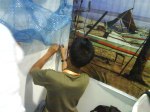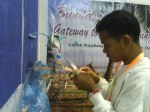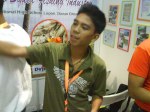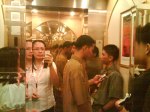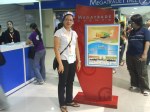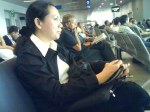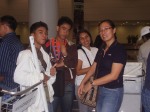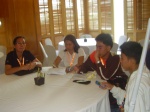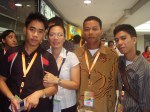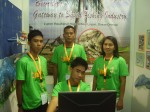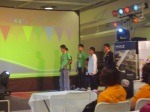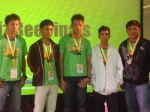Filed under: Contests, Education, Technology and Livelihood | Leave a comment »
Voice of Experience
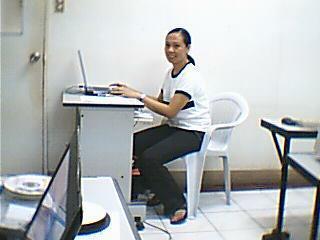
In my first year of teaching, I went through all forms of adjustment. That was the time when I had to come down from the clouds of idealism. When I first got the taste of everything that surrounded me – the students, my co-teachers, my superiors and administrators, I caught on a lot of “It can’t be this…”, “It has to be this…”, “This is impossible!” Complaints… endless complaints. I felt as though I couldn’t settle for anything less. Deep inside, I thought I knew a lot. I felt like a messiah – able and powerful to change and put everything in order. (Messianic concept… anyone?)
I couldn’t believe the results of the exam of my students the first time I gave a test – many of them got zero! When I worked with the personnel, a bulk of work were left undone. I felt as though I was about to burst! What was going on? Later, I came to realize that my college education was not enough to prepare me for this battle. I needed first hand experience to fully figure out what it was like to be a teacher… to be an educator.
Seventeen years passed and somehow, I could already pinpoint my limits, my importance and my place in a great bulk of educational system. I might not be able to change the system but I could still do something in my role and in my obligation as a teacher. Now I personally disagree with those who make education a second-best course because it is but more than a mere consolation to witness a group of young boys and girls who were once my students graduated with honors. They would leave the portals of the school with the fondest memories of all – their school life with everybody and everything on it and – and not so surprinsingly – we’re part of them.
The kind of person or teacher we are undoubtedly leave an indelibe mark on the student’s character. Teachers can be very powerful because we can potently influence the students. We can make or unmake them. The students’ laughter, problems, inhibitions and confusions are not theirs alone but also ours. Unconsciously, we get soaked up with their emotions and become affected in a way too. Learning that Juan’s mother and father just broke-up, and his grades are affected is not something we can smile with. Hearing that somebody in our class met an accident and would mostlikely be operated on – is not something we can shrug our shoulders about. These are but simple realities in the teacher’s life, and they’re not too nice to go through. College education may have forgotten to teach us these but the experience will.
So perhaps, like any other course, let’s think deeply and decide whether or not to be an educator. It takes not only patience, but love to survive the colorful- life that lays ahead for those who are willing enough to mold and shape the future of our country. It’s because – it’s not that easy. It doesn’t only need a teacher to be intelligent for him to teach well; not only have big hands to work well; not only have bigger ears to hear the students well; but to have a heart, a little bit bigger than the others to understand them well.
That’s what we are and that’s what we will always be.
(by Alma T. Cafe)
Filed under: Education | Leave a comment »
Experts: Alternative Search Tools Can Help Students

While Google and Yahoo remain dominant, other search sites can be valuable,too.
Educators are discovering that Google isn’t the only game in town. The search-engine giant, along with competitor Yahoo, has long been the most-used search site, but other search tools have surfaced in recent years that could help college students do more in-depth research of video and audio files and web sites that have cluttered the internet.
Blinkz is a search tool that allows users to scan more than 30 million hours of audio clips and video files from across the internet. Raymond Schroeder, director of technology-enhanced learning at the University of Illinois at Springfield, said audio and video files are translated to text, making it possible for word-based searches to find online videos.
For projects that require the research and study of political speeches, for instance, Blinkz can be more useful to students than a quick search on Google or Yahoo, Schroeder said. “It’s perfect for when you’re looking for a specific medium,” he said.
Maureen Yoder, director of the online technology and education master’s program at Lesley University in Cambridge, Mass., said the ubiquity of cell phones and smart phones could spur the rise of the human-enhanced search engine ChaCha. The Indiana-based company launched last January and invites users to send questions via text or voice for free; within minutes, the query is answered and delivered back to the phone. ChaCha’s service might not be applicable for major term papers or projects, but Yoder said its immediacy could appeal to students with a quick question during class or a study session.
“It’s one of the most innovative search tools I’ve seen,” said Yoder, who has studied search engines for more than 20 years and who hosted a forum on alternative search tools at the Sloan Consortium conference in October. “Everybody isn’t on their computer all the time, but everyone always has their cell phones with them. … It’s very new, and it’s very exciting.”
In September, ChaCha announced it’s had more than a million users and has answered 27 million queries in its first nine months on the web.
But even with the rise of alternative search tools, Google and Yahoo dominate. In March 2008, Americans used internet search tools 11 billion times—and Google and Yahoo accounted for 9 billion of those searches. Sixty percent of those searches were conducted on Google, according to published surveys.
Experts who have tracked the evolution of web-based search tools said Internet Archive could be invaluable to students searching for headlines or stories from a decade ago or longer. The site—which archives more than 80 billion web pages dating back to 1996—shows exactly what web pages looked like from the time they launched to today. For instance, a student researching a presidential or congressional election could see what CNN’s web site posted on that day and in the weeks following. “You can see exactly how events were covered on the web back then,” Schroeder said. “You can see how attitudes have changed.”
There are also a host of little-known search engines that use visuals to display pertinent search results. Sites such as Kartoo display search results with miniature, thumbnail- like versions of the web pages that result. With Kartoo, one of the web’s first visual search tools, users can scan over each option and click on the page according to its image and content.
Grokker and Touchgraph are other image-based search engines that give users a miniature preview of what they’ll see when they click on a link. Grokker provides a variety of ways to narrow or expand internet searches. Users can zoom in and out of graphic results displayed on the screen, eMail results to other users, or separate results according to date.
“I would think there are some people who would rather have a visual representation of what they find rather than a list,” Yoder said. “It’s made for a different learning style.”
A tool recently unveiled by Microsoft and a team of other web-based companies could enhance group projects on every level of education. The tool—called SearchTogether—allows people at different computers to conduct online searches together and pool the results, according to a New York Times report. Divvying responsibilities for projects, experts said, could streamline research and allow students to help each other use better search terms.
Relying solely on the giants of the web-searching world, experts said, could limit students’ research and omit findings that could enhance their understanding of subjects and make their class assignments more thorough. “I think, ultimately, using different search tools can provide much better research,” Schroeder said, adding the he expects Yahoo and Google to purchase up-and-coming search sites as they gain in popularity, especially among college-aged people. “I think these tools will be bought up by Google and others and become part of the tools we use every day.”
“If you only rely on one [search engine], then you are completely dependent on how [it] organizes information,” Yoder said. “Google is great, but the functionality of [alternative search engines] goes beyond Google.”
Filed under: Education | Leave a comment »
21st-Century Skills Map Targets English Teachers
(eSchool News: Classroom News, Volume No. 4, 12- December 2008)
New Framework provides models for infusing 21st-century skills into the English classroom.
English teachers now have a free new resource to help them infuse so-called 21st-century skills into their curriculum,thanks to a collaboration between the Partnership for 21st Century Skills (P21) and the National Council of Teachers of English (NCTE). This new resource—a framework that provides teachercreated models for how 21st-century skills such as problem solving, critical thinking, communication, collaboration, and creativity can be incorporated into English classes—is part of P21’s effort to create curriculum maps that demonstrate how to teach key 21st-century skills inthe classroom. Earlier this year, the organization released similar guidance for social-studies teachers. (Read “New resource helps teach 21st-century skills.”) http://www.eschoolnews.com/news/top-news/news-bysubject/index.cfm?i=54606 By offering sample lessons that combine 21st-century skills with interdisciplinary themes such as global awareness and civic, economic, and entrepreneurial literacy, the new English map gives concrete examples of how to align teaching and learning with the standards of the 21st century.
“This framework, which includes examples taken directly from proven classroom practices, represents an exciting tool for teachers and students as they move toward a 21st-century education system,” said Kylene Beers, NCTE president. “The map also mirrors the evolving nature of NCTE, as we ensure our organization and members possess the tool and resources that are required for success in the 21st century.” The map cites specific student outcomes and provides models that aim to help student achievement in grades four, eight, and 12. For example, fourth graders, after reading folktales and watching two or three cartoons, might write their own contemporary version of a folktale and present it as a stop-motion or claymation film. NCTEand P21 say this activity helps students learn how to communicate new ideas to others and demonstrate originality and inventiveness in their work. At the eighth-grade level, to help learn financial awareness and literacy, students might conduct research to answer the question: “How much schooling do you need to get the kind of job you would like to have?”
After investigating salaries, employment outlooks, and education or training requirements for their possible careers, students create a chart comparing their top three to five choices and write short personal essays explaining how these choices fit their goals. As a result of these tasks, eighth graders would begin to analyze and make complex decisions, learning to identify and ask significant questions to clarify points of view. At the high school level, teams of students might create a virtual field trip for elementary school students. In addition to creating a video and narration detailing the site, students would research background information and interview appropriate experts such as park rangers, tour guides, and historians. The students then would use a project management tool to organize tasks, assignments, and deadlines. Through this project, students would assume shared responsibility for collaborative work and demonstrate the ability to work effectively with diverse teams, as well as creativity in planning an interactive experience for younger students. “I commend NCTE and English teachers across the country for providing a framework that shows how the discipline is incorporating 21st-century skills,” said Ken Kay, P21 president. “This work highlights the partnership’s mission to develop innovative tools that integrate 21stcentury skills into the curriculum and positively impact student learning.” Additional maps will be available for mathematics, geography, and science in 2009, the organization said.
Filed under: Education | Leave a comment »








